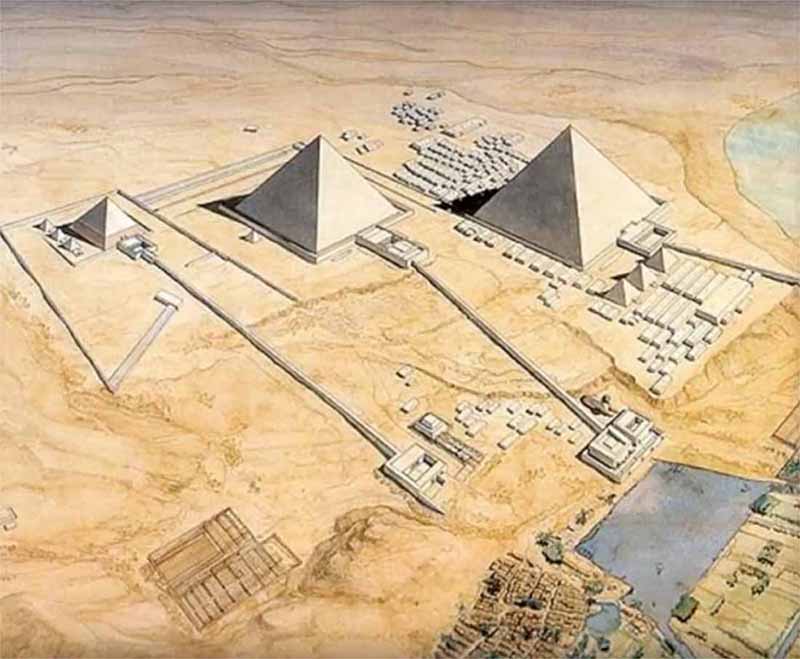
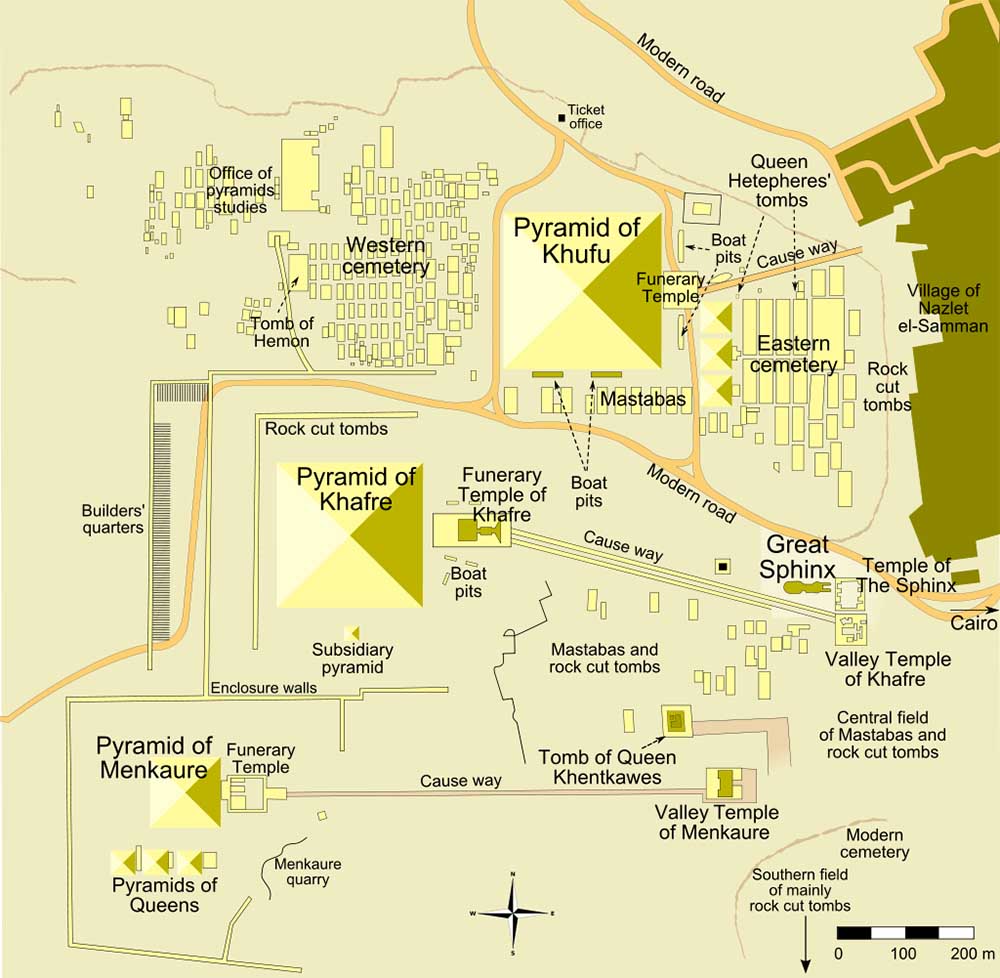
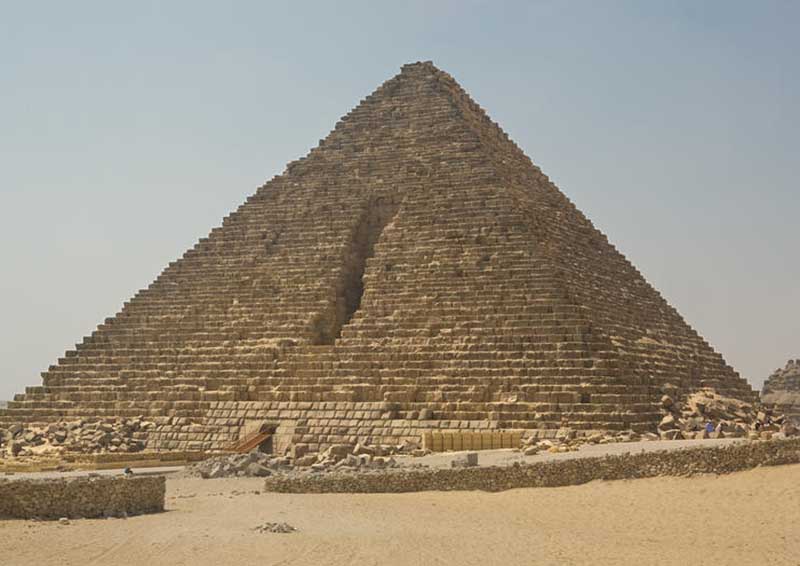



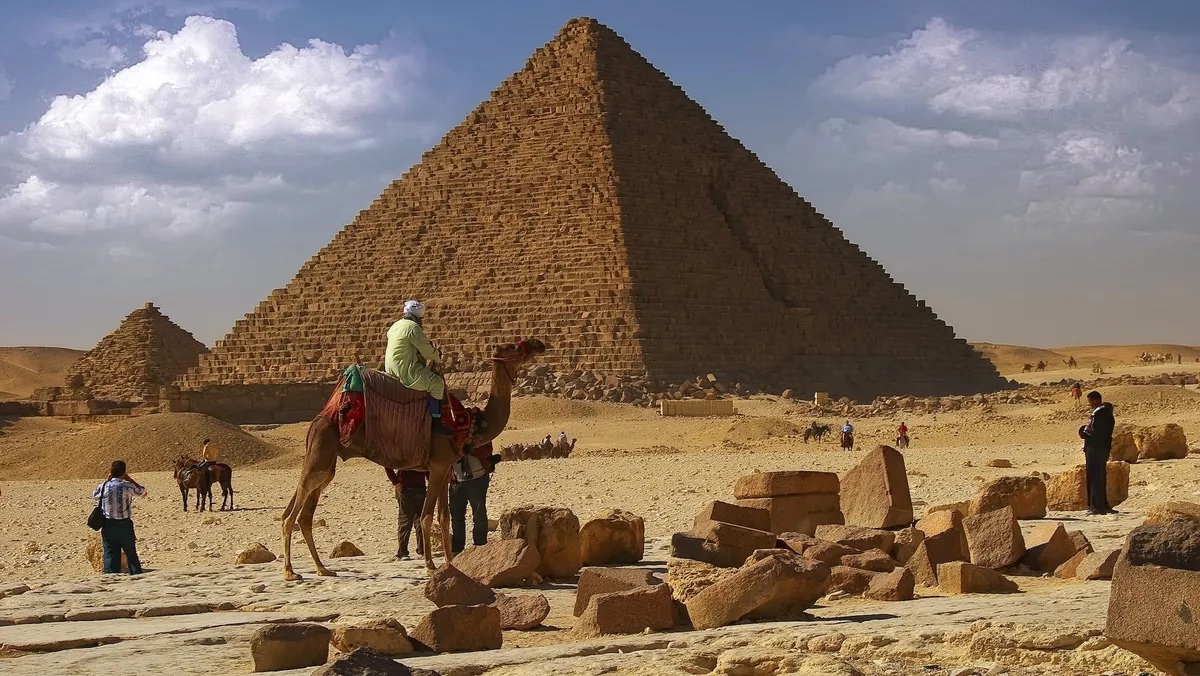
Two voids detected on the eastern side of the Pyramid of Menkaure on Egypt's Giza plateau hint at a second, hidden entrance to the pyramid, according to a new study. Live Science - November 10, 2025
The pyramid was built during the reign of the pharaoh Menkaure (circa 2490 to 2472 B.C.). It's the last and smallest of the three pyramids built on the Giza plateau and originally stood about 213 feet (65 meters) tall. The main entrance to the pyramid is located on the northern face. The eastern side of the pyramid contains an area of polished blocks that have long puzzled researchers. The stones are remarkably polished over an area around four meters [13 feet] high and six meters [20 feet] wide. Such smooth stones are otherwise only found at what is currently the only entrance to the pyramid, on the north side. The unusually polished granite blocks on the pyramid's eastern face have puzzled experts for some time. This smooth section, about four meters tall and six meters wide, resembles the finish used at the pyramid's known entrance on the north side. This distinctive stonework might mark the location of a second entrance.
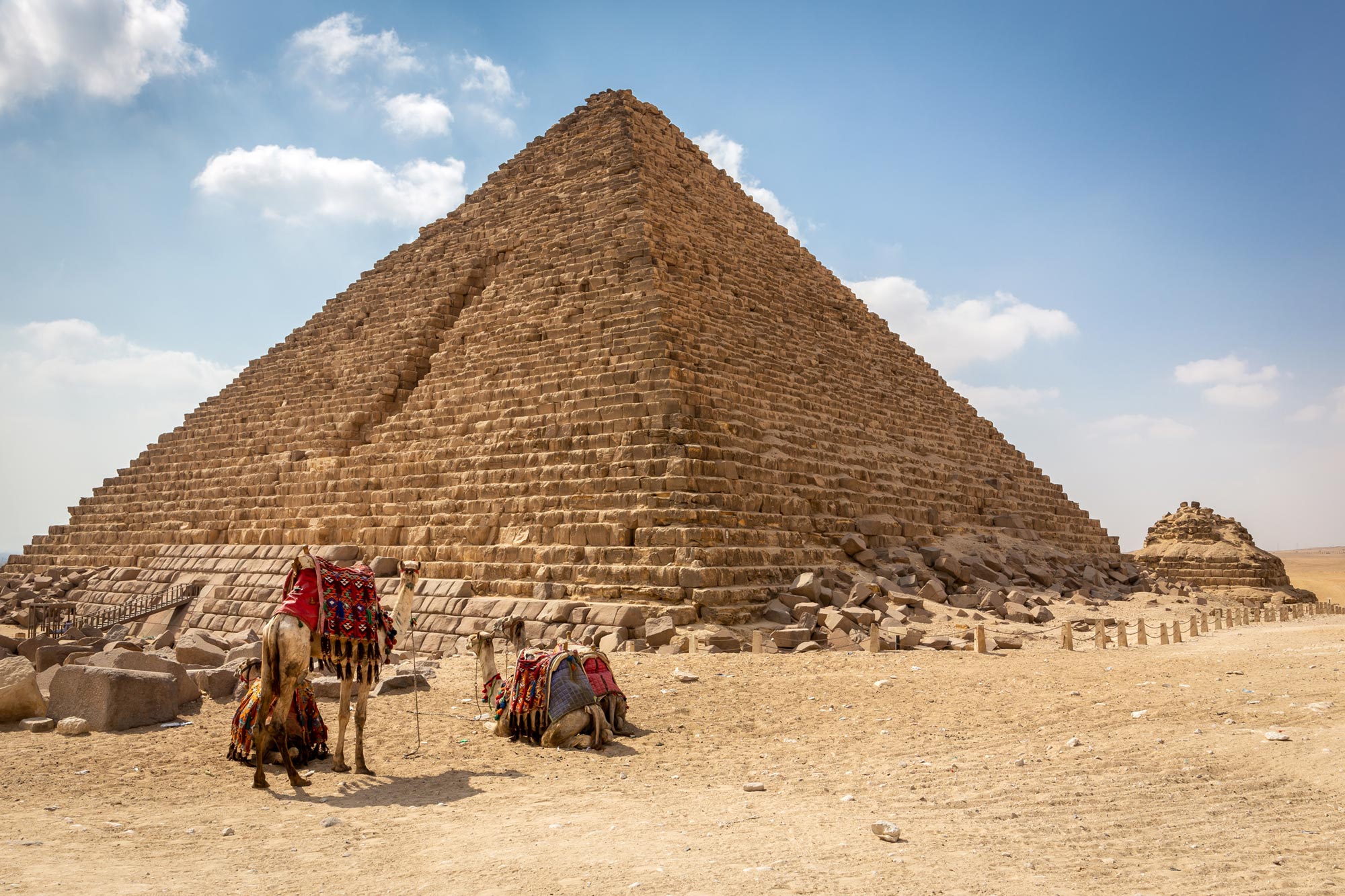
Hidden Chambers Found in Menkaure Pyramid The youngest of the Giza pyramids and unique for its extensive use of Aswan granite - Discovered two mysterious void spaces SciTech Daily - December 7, 2025
Researchers from Cairo University working with the ScanPyramids project have uncovered two hidden air-filled spaces inside the third-largest pyramid at Giza. For years, archaeologists suspected that an additional entrance might exist on the eastern side of the Menkaure Pyramid, and the new findings offer the first scientific support for that idea. By using radar, ultrasound, and electrical resistivity tomography (ERT), the team confirmed the presence of two voids beneath the eastern exterior, strengthening the long-standing hypothesis.
Menkaure was an ancient Egyptian king (pharaoh) of the fourth dynasty during the Old Kingdom, who is well known under his Hellenized names Mykerinos. He was he grandson of Khufu. Menkaure became famous for his tomb, the Pyramid of Menkaure, at Giza and his beautiful statue triads, showing the king together with his wives Rekhetre and Khamerernebty and with various deities.
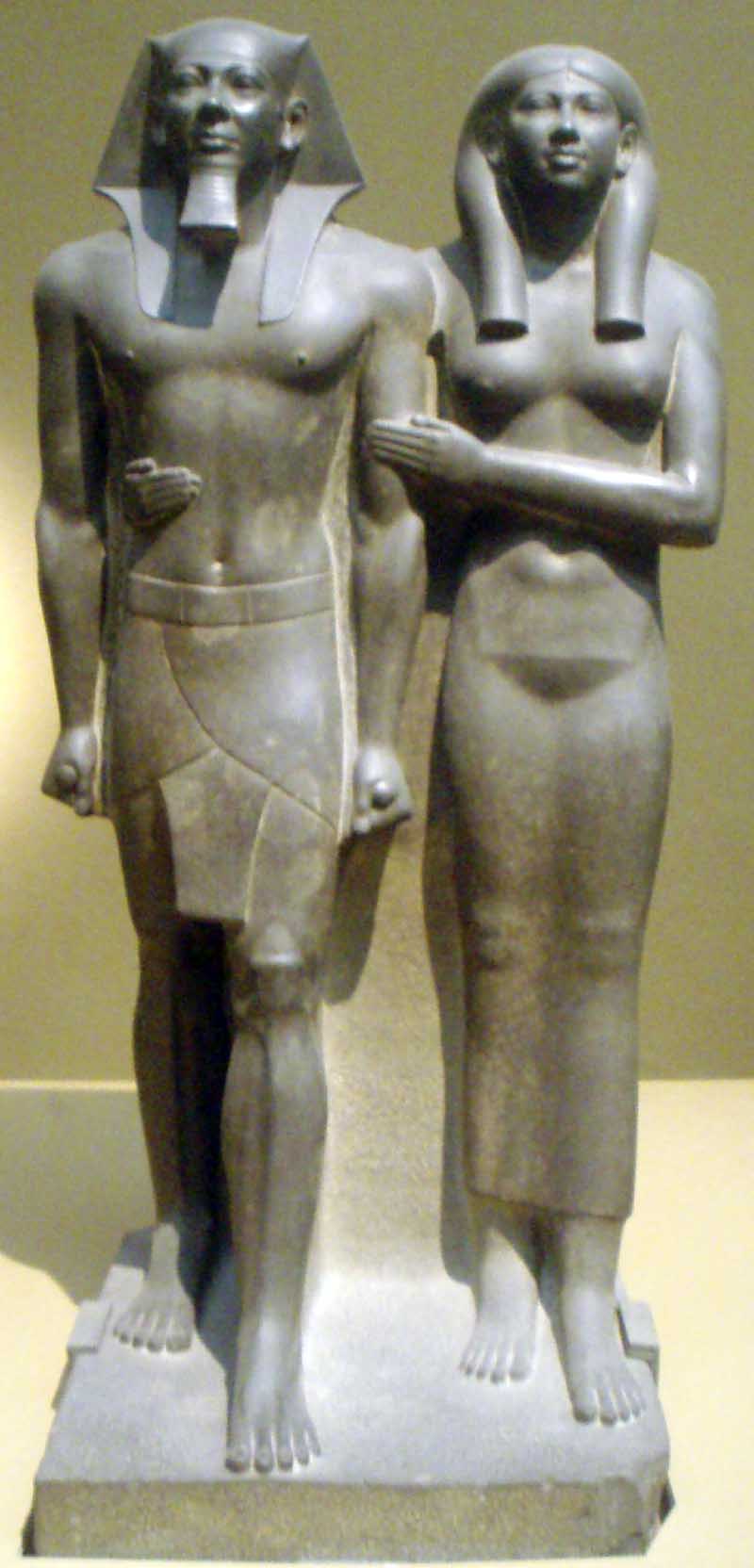
Menkaure with Goddesses Hathor and Menkaurees
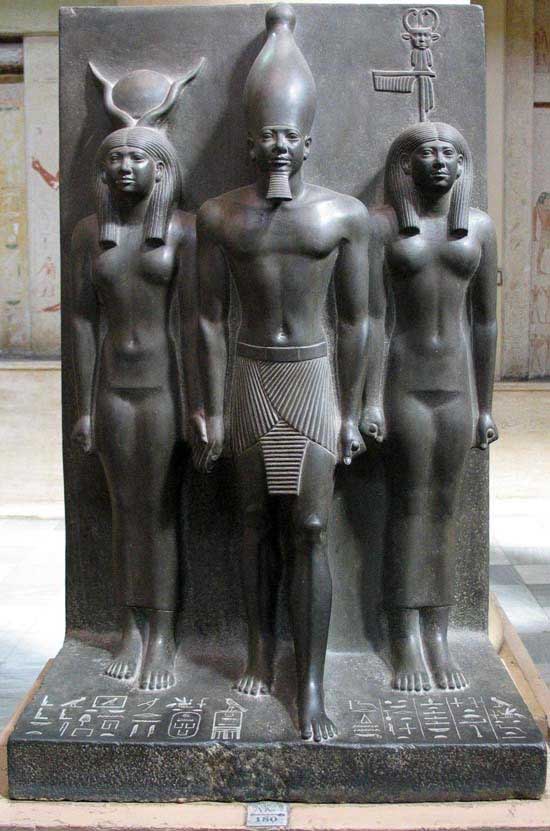
Menkaure apparently intended for his pyramid on the Giza Plateau to be the last of that specific area of the Memphite necropolises which it is, as well as being the smallest. The valley temple lies at the mouth of the main wadi, closing what had been the principal conduit for construction materials brought to Giza for three generations. Named "Menkaure is Divine", the pyramid was thought by some Greeks, according to Herodotus, to belong to the Greek hertaera Rhodopis. Manetho thought that it belonged to Psamtik I's beautiful daughter, Nitokris.
Diodorus Siculus first described the inscription that bears the name of Mykerinos on this pyramid, but it was not until Vyse in 1837 that anyone actually entered Menkaure's pyramid. He began by investigating its substructure by following a tunnel dug earlier by Caviglia out of a breach in the north wall. The original entrance was not discovered until later.
Surprisingly, Lepsius paid almost no attention to this pyramid, and even Petrie worked on it for only a short period in the 1880s. Luckily, George Resiner who was one of the most advanced archaeologists of his time, won the concession for Menkaure's pyramid when archaeologists drew lots for excavating Giza on the balcony of the Mena House Hotel in 1899. He knew beforehand that this pyramid, though small, could provide some rich finds because his assistant, Arthur Mace, had reconnoitered the site. He began a very thorough excavation of the entire complex in 1906 directing a team from Harvard University and the Boston Museum of Fine Arts. Those excavations continued until 1924.
Menkaure's pyramid, with its original height of some 65-66 meters, represents only about 1/10th of the mass we find in Khufu's pyramid. However, this may be the result of a theology which dictated more emphasis on the temples and less on the pyramid, a process evident to us already in the reign of Khafre which continued throughout the Old Kingdom.
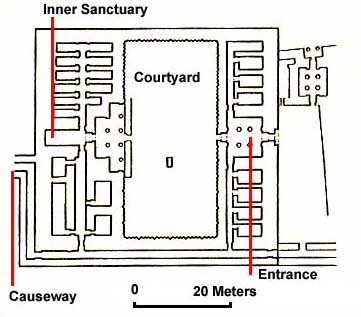
The reconstruction of Menkaure's valley temple is more difficult than any other element within his pyramid complex. The west part of the limestone block base and lower part of the core of the temple's north wall were probably completed during the ruler's lifetime, while the remaining clay masonry would be attributable to his son, Shepseskaf. Just behind the portal to the temple there was a square antechamber adorned with four columns. The alabaster (calcite) bases of these columns, pressed into the clay floor, have been preserved.
On either side of this room are four storerooms. Behind the entrance antechamber, the whole middle part of the valley temple consisted of a huge open courtyard with inner walls decorated with niches (similar to the mortuary temple's courtyard).
A path, paved with limestone slabs, ran from the pillared antechamber through the center of the courtyard to a low stairway, which in turn led through a portico with two rows of wooden columns. This terminated at an offering hall, in which an alabaster altar may have once stood. To the north of the offering hall were twelve storerooms, and to its south were five additional storerooms.
This was the area where Reisner found the famous, mostly triad statues of the ruler, along with four unfinished statuettes of Menkaure, fragments of other statues and stone vessels. Three of the statues discovered by Reisner depicted the goddess Hathor on the ruler's right side, with divinities symbolizing three Upper Egyptian nomes on his left. These may have been part of a larger collection of statues for each of the provinces of Egypt, or perhaps only the nomes that provided endowments for the complex.
Perhaps curiously, the function of the valley temple changed over time. Reisner retraced the process by which houses of the pyramid town first crowded up against the front wall of the temple, and then began to be built within it. People began living in the temple itself, particularly in the courtyard, where grain storehouses and lodgings were built.
Perhaps as early as the 5th Dynasty, the temple was badly damaged by water after a particularly heavy rain tore away the temple's west side. Reisner believes that the temple was rebuilt, at least roughly, during the reign of Pepi II.
More recently, an Egyptian archaeologist, Selim Hassan, while excavating the nearby tomb complex of queen Khentkaues I, discovered a small brick structure with a platform, low benches and a small drainage canal, together with a basin at the northeast corner of Menkaure's valley temple. Stored there were a large number of flint blades and stone vessels. Some Egyptologists believe that this structure was used for a "purification ten" and was only a part of a larger structure where the mummification ritual took place.
Another modification of the valley temple was a brick structure built in front of the temple's west wall. It may have provided a widened portal, giving better access between the temple and the pyramid town.
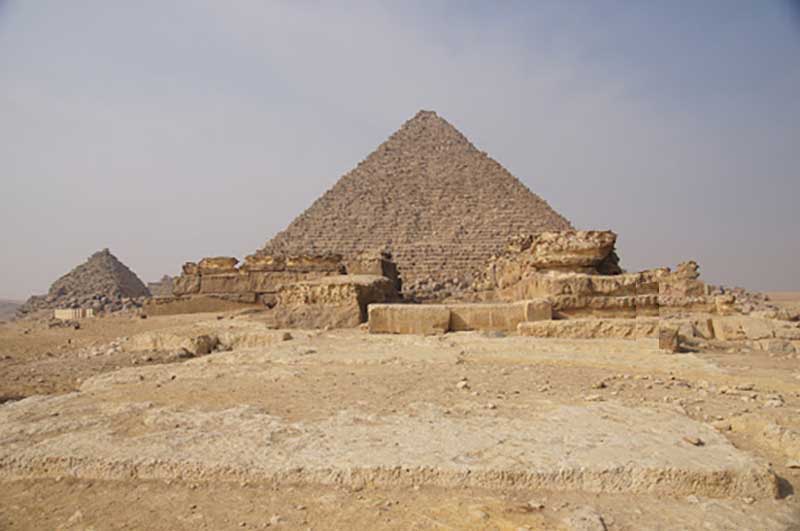
The causeway of this pyramid complex leading from the Valley temple to the Mortuary Temple was most likely completed by Shepseskaf. It had floors made of limestone blocks and highly compressed clay mixed with limestone fragments. The mudbrick walls that were a little more than two meters thick supported a roof. Reisner believed that the roof was made of wooden beams and mats because he found the remains of such material at the end of the causeway. However, others Egyptologists, because of the width of the side walls and architectural elements of nearby tombs of close family members, believed that there would have been a vaulted roof of brickwork.Nevertheless, the causeway was never completed. Work seems to have stopped at the point where it meets the west side of the old Khufu quarry. From there to down to the valley temple, the causeway was probably never more than a construction ramp for delivering stone. Hence, we really do not know how it was to connect to the valley temple. Yet some Egyptology resources believe that it would have not begun at the west part of the valley temple, but rather would have actually run along its whole south side and part of its west side. They believe it was even accessible from the storerooms in the valley temple's southern section.
Like Menkaure's predecessors on the Giza Plateau, his mortuary temple was not built adjacent to his pyramid's east wall. The original temple obviously remained partially uncompleted, we believe, as a result of Menkaure's sudden death. Menkaure began this mortuary temple, as had Khafre, with core blocks of limestone that were locally quarried. The heaviest of these, found at the northwest corner of the temple, is the heaviest known at Giza, weighing some 200 tons.
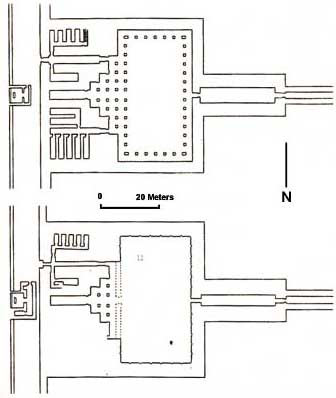
Mortuary Temple (Bottom) at the time of Menkaure's
death and (above) after Shepseskaf completed it.
Though we know the mortuary temple had an almost square ground plan, its appearance can only be partially reconstructed. Reisner believed that an entrance corridor led from the east terminating in an open courtyard that was meant to be ornamented by pillars. The inside wall of this courtyard was lined with plastered and whitewashed brickwork decorated with niches, which was probably added by his successor in order to complete the temple after Menkaure's death. There was also a small shrine built within the courtyard, that Reisner also dated to the reign of Shepseskaf.
In the west part of the temple, a portico made up of two rows of pillars provided access to a long offering hall. According to Reisner, there was a false door in the offering hall's west wall. However, because of statuary fragments, and the fact that the temple was not immediately adjacent to the pyramid, scholars such as Maragioglio and Rinaldi rejected the idea of a false door, instead seeing a statue of the ruler standing in its stead. They do believe that a false door existed, but that it stood on a small, pink granite platform in front of the pyramid's east wall. In Maragioglio and Rinaldi's view, it would have at first been easily accessible from the east wing of the pyramid's courtyard, before additional rooms were built in the area.
A limestone altar and fragments, including a head, chest, lap, knees and shins of a seated statue of Menkaure, rendered in pink granite were found in the five, two story magazines that form a northwestern part of the mortuary temple. This statue was perhaps meant to be the centerpiece of this entire complex. Originally it stood at the back of a tall and narrow east-west hall at the end of the center axis of the temple, so that the king looked across the open country, through the entrance hall, and down the line of the causeway to the land of the living. The southwest part of the temple remained uncompleted.
Reisner, as well as other Egyptologists, thought that the whole mortuary temple was originally meant to be constructed of pink granite. In fact, we can see that Menkaure's masons had just started bringing in a series of granite blocks on both sides of the corridor. They were cutting back the large limestone core blocks to ensure that the front faces of the granite blocks were flush. When Reisner removed the mudbrick from the casing he found bright red paint on the core blocks marking leveling lines, measurements and the names of the work gangs. However, Ricke rejected this analysis, believing that only the dado was to be made of this fine stone. Irregardless, the temple was not completed by Menkaure, but by his son, using mudbrick, evidenced by an inscription on one of the fragments of a stela that Reisner discovered.
Interestingly, there was also within the mortuary temple a small square room with a single pillar. It had a strikingly similar appearance to the antechamber carree that actually first appears in the mor4tuary temples of the 5th Dynasty pyramids. Menkaure Some elements within the temple may even be dated beyond the reign of Menkaure's son, including the stelae of Merenre I and Pepi I.
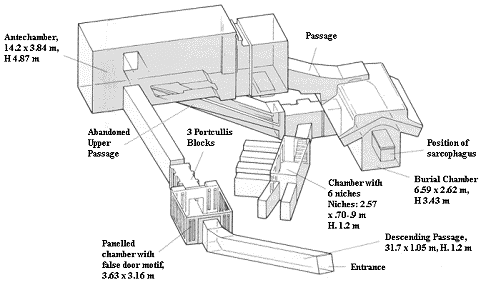
Isometric drawing of the pyramid chambers
Menkaure's pyramid lies at the far end of the Giza diagonal on the very edge of the Mokattam Formation, where it dips down to the south and disappears into the younger Maadi Formation. Just as with his father, Khafre's nearby pyramid, Menkaure's construct had to have a very well prepared rock subsurface, particularly around the northeast corner. This base is two and one half meters higher than his father's pyramid and and occupies a mere quarter of the area consumed by Khafre and Khufu's pyramids.
It has a core of local limestone blocks, with casing made of unfinished pink granite from Aswan up to a height of about fifteen meters. Further up, the casing was probably made of fine, Turah limestone. Because completely finished casing blocks would have probably been damaged during transport and installation, particularly at their edges, the final finishing touches were not completed until the very end of the construction process. This also made it possible to achieve a very accurate fitting along the whole surface of the pyramid walls. There is an inscription on the granite casing of the north wall that dates from the Late period, and may be the one mentioned by Diodorus.
Original access was provided to the inner chambers by an entrance on the axis of the north wall, about four meters above ground level. From there, a descending corridor, only partially lined with pink granite, sloped down at an angle of a little more than 26 degrees for 31 meters through the masonry core to the chambers below. This "lower corridor" terminates in a room with walls that were provided with niches. The purpose of this unusual room is still debated among scholars. However, the niches represent the first purely decorative element inside a pyramid since Djoser's Step Pyramid at Saqqara. At the beginning of the next corridor, there is a granite barrier that is made of three blocks that were lowered after its completion. The following corridor continues at a slight downward angle until it comes out in a relatively small, east-west oriented upper antechamber with wall that are completely undecorated. The east end of this chamber is located directly under the vertical axis of the pyramid.
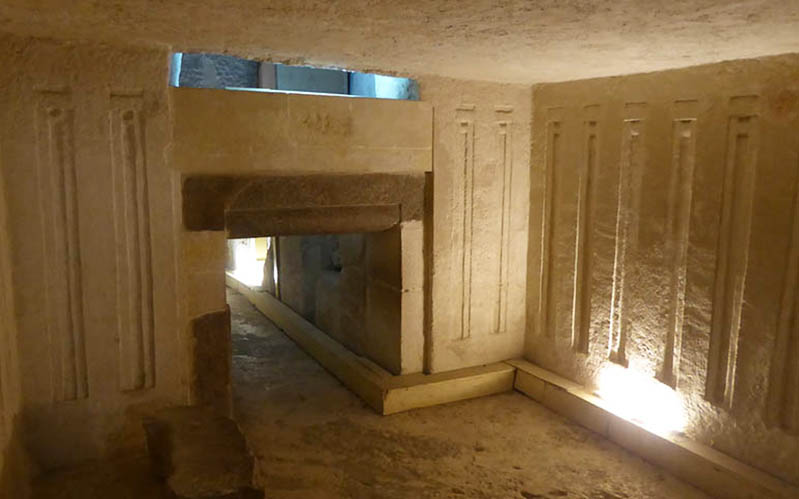
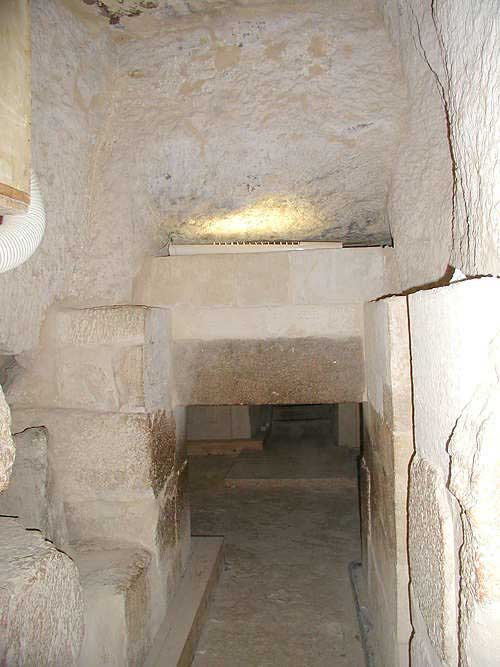
Here, another passageway known as the "upper corridor" runs over the "lower corridor" through a short horizontal section before climbing in a north-south direction into the pyramid core, were it terminates. It is very likely that this double corridor system signals a change in the original construction plans. The "upper corridor" was probably abandoned when the floor of the antechamber was lowered. From this, Petrie believed that the original pyramid was only about half the size that it is today, though others such as Stadelmann doubt his analysis.
In fact, the substructure of this pyramid underwent significant changes. Investigations of both this pyramid, and the tombs of his royal family that are closest in time (Mastabat Faraun and Khentkaues I's stepped tomb) point to the development of these subchambers in three phases, during which the original plan was enlarged.
In the antechamber, Vyse unearthed the remains of an anthropoid wooden coffin with, Menkaure's name Within were human bones. Most scholars today believe this coffin was inserted, perhaps in an effort of restoration, into the pyramid during the Saite period late in Egypt's ancient history. However, the bone fragments were even more recent as revealed by radio carbon dating, that shows hat they probably date to the Coptic Christian period of some two thousand years ago. There is a rectangular indention in the west section of the antechamber floor, suggesting that a sarcophagus may have once been intended for this room.
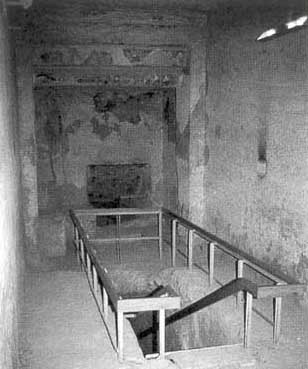
However, from the middle of the floor of the antechamber, another granite corridor leads downward before becoming horizontal shortly before the actual burial chamber. Just before the entrance to the burial chamber, a short flight of steps leads to an area with six small, deep niches, sometimes known as the "cellar", which has an undetermined function, though there is a similarity to architectural elements in the Mastabat Faraun of Shepseskaf and the stepped tomb of Queen Khentkaues I.
Four of the niches are on the east side, and Ricke believed that these were to hold the four canopic vessels containing Menkaure's entrails. He believed that the two additional niches on the north side may have been graced with the crowns of Upper and Lower Egypt. However, others believe it may be a forerunner of the three chambers to the left (east) in the standardized substructures of 5th and 6th Dynasty pyramids, though it may have simply been used to store funerary equipment and supplies.

Unlike the pyramids of his father and grandfather (Khufu), the rectangular burial chamber is oriented north-south. It is completely covered in pink granite, including even the gabled ceiling, which was actually hollowed out from beneath to make a round, barrel vault. The chamber lies some 15.5 meters beneath the level of the pyramid's base so that the ceiling could be constructed of nine pairs of enormous granite blocks. This construction was carried out after the modification of the plan for the substructure, which made it both difficult and laborious to complete. It required a large descending tunnel to be built in the west part of the upper antechamber, from which visitors today may actually view the top of the vaulted burial chamber.
It is very possible that both the granite burial chamber and the set of niches were built after the after the death of Menkaure on the instructions of his son and successor, Shepseskaf.
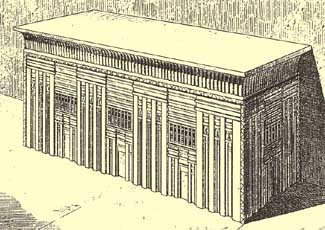
On the burial chamber's west wall, Vyse discovered a wonderful, dark basalt sarcophagus that was decorated with niches in the palace facade style. The sarcophagus was empty, and its lid was missing. However, fragments of the lid were discovered, which indicate that it was ornamented with a concave cornice. Ricke saw in this design certain similarities with the decorations in shrines dedicated to the god Anubis, and thought that they were an attempt to provide additional protection for the tomb by means of that divinity. Alas, we are left with only drawing of this piece of funerary equipment, for the ship, Beatrice, which was taking it from Egypt to the British Museum leaving Leghorn sank somewhere between Malta and Spain in 1838. Fortunately, the anthropoid coffin was sent in a separate ship that reached its destination.
Interestingly, in contrast to Khufu's and Khafre's pyramids, there have been no boat pits discovered in relationship to Menkaure's pyramid, despite intensive investigation by an Egyptian archaeologist named Abdel Aziz Saleh, who obviously thought that they should exist.
Already in the late 1630s, the English scholar and traveler John Greaves noted that the casing had largely been removed. The destruction of the pyramid lasted well into the 19th century, when Muhammad Ali Pasha (1805-1848) used some of the pink granite blocks taken from its casing to construct the arsenal in Alexandria.
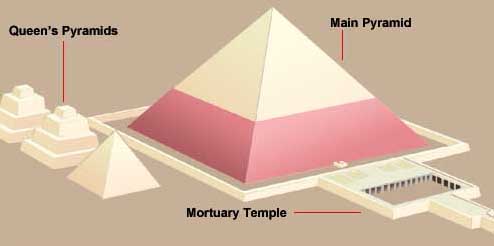
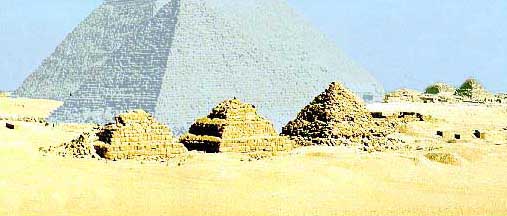
The Three Queen's Pyramids, from left to right: G 3c, G 3b and G 3a
Pyramid G 3a
Original height: 28.4 meters
Angle of inclination: 52o 15'
Length of sides of base: 44 meters
Pyramid G 3b
Length of sides of base: 31.24 meters
Pyramid G 3c
Length of sides of base: 31.24 meters
Notable on the Giza Plateau are the three much smaller subsidiary that stand in a row along the south wall of the principal pyramid. Designated G 3a-c, archaeologist attribute them to Menkaure's royal consorts. Of these, only G 3a was a true pyramid, the other two having a four step core, and some Egyptologists believe that it functioned as a cult pyramid, though it was also clearly used for a burial. All three of these pyramids were surrounded by a common perimeter wall.
G 3a, the easternmost, of these pyramids, actually had a small, east-west oriented mortuary temple of its own that was accessible from it's pyramid's courtyard. This mortuary temple was probably partially built of limestone, but was hastily finished with mudbrick. The west end of the mortuary temple was dominated by a fairly large, open courtyard that had niches built into its northern wall. On its south side was a row of wooden columns. A small cult chapel with an entrance adorned with deep, double niches to either side, lead into an offering room that included a false door. storage annexes were located in the northwest part of the temple, and in the southwest a staircase led to the roof terrace.
Pyramid G 3a was the largest of the three constructs, with an entrance situated in the middle of the north wall, only a little above ground level. It has a substructure consisting of a burial chamber dug from the rock under the center of the pyramid's base, which communicates with a descending entrance corridor equipped with a barrier. This burial chamber was originally equipped with a pink granite sarcophagus, embedded in the floor next to the west wall. Unfortunately, it soon fell prey to tomb robbers. There were also fragments of ceramics and charred remains of wood and matting found in this chamber.
We really have little idea who was interred in Pyramid G 3a. Reisner thought that it might be Menkaure's principal consort, Khamerernebti II, but based on a statue of that queen found in the so-called Galarza tomb in the central part of the Giza necropolis, others believe that she was buried alongside her mother, Khamerernebti I in that tomb. In fact, it is not impossible that this pyramid was originally simply a cult pyramid that was latter transformed into a tomb.
Besides being smaller, and lacking the shape of a true pyramid, G 3b also differs in other details. These include the placement of the descending corridor, which lacks a barrier. The bones of a young woman were found in the pink granite sarcophagus which stood against the west wall of the burial chamber that was located under the northwest part of the pyramid. Like G 3a, it also had a small mortuary temple, though in this case it was oriented north-south.
G 3c was never completed with its casing. Like G 3b, the burial chamber was constructed under the northwest part of the pyramid, and was likewise not finished. Though no burial was found within this pyramid, there was clear evidence of a cult following in the small mortuary temple that stood in front of the east side of this pyramid. Also like G 3b, this mudbrick structure was oriented north-south.
Unfortunately, the owners of G 3b-c are completely lost to us and may never be known. We are relatively certain that they were consorts of Menkaure, but otherwise there no information on these royal women.
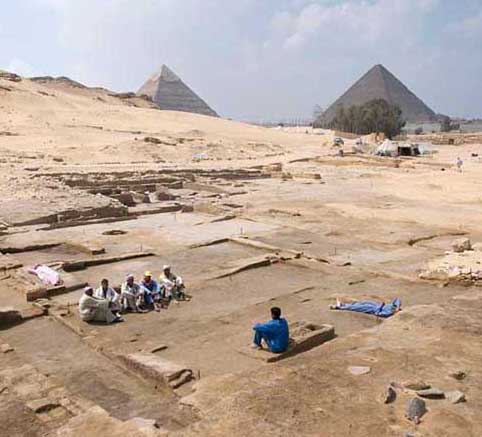
Leopard Teeth, Calf Bones Found in Ruins Near Pyramids Live Science - January 21, 2014
The remains of a mansion that likely held high-ranking officials some 4,500 years ago have been discovered near Egypt's Giza Pyramids. Bones from young cattle and teeth from leopards suggest its residents ate and dressed like royalty. Archaeologists excavating a city just 400 meters (1,312 feet) south of the Sphinx uncovered the house and nearby mound containing the hind limbs of young cattle, the seals of high-ranking officials, which were inscribed with titles like "the scribe of the royal box" and "the scribe of the royal school," and leopard teeth (but no leopard). The house, containing at least 21 rooms, is part of a city that dates mainly to the time when the pyramid of Menkaure (the last of the Giza Pyramids) was being built.
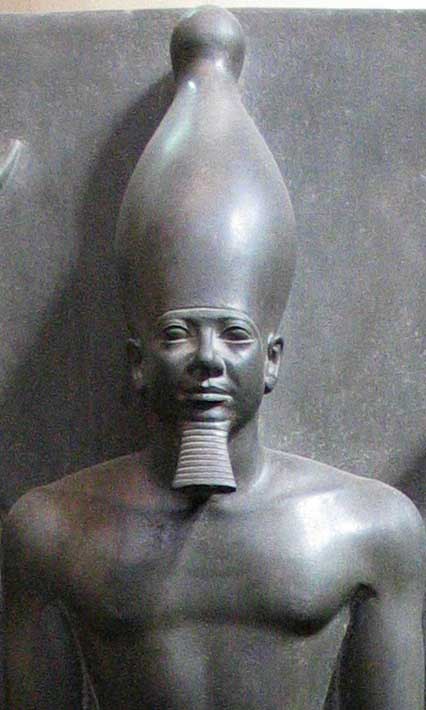
Menkaure